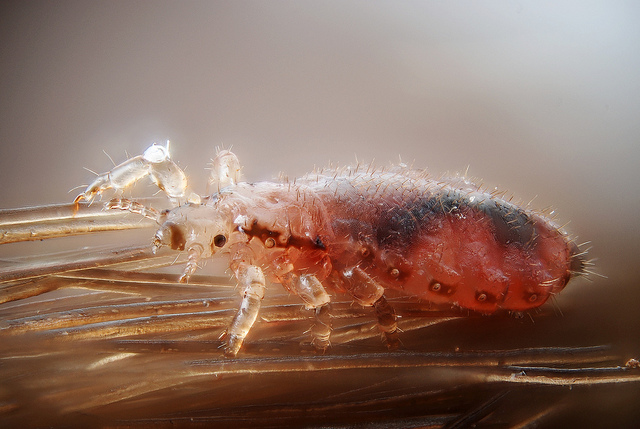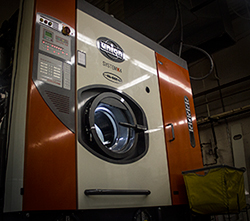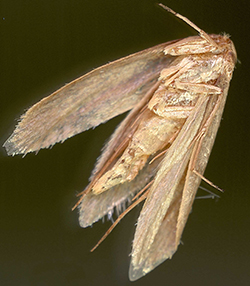Back to School Bugs
From the Drycleaning and Laundry Institute Back to School Bugs Kids love to share. And, that includes head lice. Yuck. But what to do? Head lice need the warmth, food, and moisture that a human scalp provides. Away from people, lice usually will die within three to 10 days. The following steps will help eliminate head lice from your clothing and household fabrics. Wash bed linens and washable clothing in hot water (140°F) for 20 minutes. Heat dry clothing or other fabric items in clothes dryer. Items that cannot be washed or drycleaned should be stored for 30 days in sealed plastic bags. Use only insecticides approved for use against lice. Read and follow the instructions....
Read MoreMaking Your Clothes Last Longer
From the Drycleaning & Laundry Institute Making Your Clothes Last Longer You have probably completed your back-to-school shopping for the kids and may be amazed how much they have grown in the last few months. While relatives and friends may be pleased with welcoming those outgrown clothes into their homes, you may be staring into your closet thinking, how can I make my wardrobe last just a bit longer? Follow these suggestions for proper clothing care: Do not hang wet or moist garments in the closet. Mend all rips and tears immediately, especially before the garment is subjected to a cleaning process. Do not store dirty clothing from one season to the next. Treat and remove all stains as soon as possible after spillage has occurred. Clean clothes frequently. Soiled clothes invite insects. Follow the care instructions and do not remove care labels. Carefully inspect garments after each wearing to determine the need for repairs or cleaning. Do not allow perfumes, hair spray, or lotions to come in contact with wearing apparel, as the alcohol contained therein may cause color loss. Do not store or allow garments to be in prolonged or direct contact with artificial or direct light. ...
Read MoreAbout Dry Cleaning
From Straight Talk about Drycleaning, prepared as a service of the Consumer Relations. Division of International Fabricare Institute DRY-CLEAN (dri’-klen) Vt. To clean (clothing, etc.) with solvents other than water, such as carbon tetrachloride. Dry cleaning is very similar to washing, but a solvent is used rather than water. The solvents used before 1930 were typically like kerosene or gasoline. Drycleaning a garment would look almost like washing it in a front loading home washer, but rather than water, the washer would have a liquid solvent in it to clean the garments. Professional garment care goes back to ancient times, probably beginning with the advent of textile clothing itself. The ruins of Pompeii give us a record of a highly developed trade of “fullers,” who were professional clothes cleaners. lye and ammonia were used in early laundering, and a type of Clay called “fuller’s earth” was used to absorb soils and grease from clothing too delicate for laundering. There are many stories about. the origin of drycleaning, all centering on the supposed discovery that when a petroleum-type fluid was accidentally spilled on a greasy fabric it quickly evaporated and the stains were miraculously removed. The firm of Jolly Belin, opening in Paris in the 1840’s, is credited as the first drycleaning firm. In those early days, “garment. scourers and dyers” found several fluids that could be used as drycleaning solvents, including camphene, benzola, kerosene, and gasoline. These solvents are all dangerously flammable, so drycleaning was a hazardous business until the introduction of Stoddard solvent in 1926, the first petroleum solvent produced specifically for drycleaning. This solvent does not, ignite readily and has the added advantage of being free of odor and impurities. In the 1930’s perchloroethylene, a nonflammable solvent, was introduced and is still used today in many drycleaning plants. Oak Forest Cleaners is the first dry cleaners in Arkansas to switch to SolvonK4. It is a completely non-toxic, halogen free organic solvent with a pureness of >99%. It has excellent cleaning performance and leaves your clothes feeling smooth and it is also odor-free! There is no real mystery about drycleaning. Dry cleaning is simply the use of a solvent to remove soil and stains from a fabric. It is called drycleaning because the solvents contain little or no water. So when you think of drycleaning, don’t think of mysterious powders. Think of Oak Forest Cleaners....
Read MoreSummertime Stains
Perspiration is just a part of life in Arkansas right now. Perspiration, antiperspirants, and deodorants can cause stains, rings or streaks to appear on your clothes. Sometimes these tan or yellow stains appear after cleaning, laundering, or just after a period of time in use or storage. There may also be sudden color loss areas on or near the neck, underarm, and wrists areas of golf shirts or silk blouses. How Does This Happen? Antiperspirants, deodorants, perfumes and even perspiration can contain mild oxidizing agents that can cause these stains to appear over time. These substances can turn fabric yellow or brown, or cause colors to fade. The heat used in cleaning, drying and pressing can accelerate this process; therefore these stains may become much more noticeable after cleaning. Prolonged exposure to antiperspirants, lotions and perfumes may also result in chemical damage to fibers that weakens them and appears as holes or tears around necklines and underarms, especially with silks. Usually the fabric remains intact until the agitation of washing or dry cleaning. What can be done? If these stains are removed right away, permanent damage can be prevented. Knit golf shirts should be cleaned as soon as possible after a hot day in the Arkansas sun. Some helpful tips: Use a deodorant with a neutral pH instead of an acidic antiperspirant. Some antiperspirants are extremely hard on fabrics. After a hot day of perspiring, make sure you clean your garments as soon as possible. Avoid overuse of deodorants, lotions and perfumes. If you notice any color changes, it may be too late. Bring the item to Oak Forest Cleaners as soon as possible and we will see if the damage is reversible. More Information from the International Drycleaning & Laundry Institute: Antiperspirant Potential Problem: Build-up from deodorant and antiperspirant products can cause fiber damage and yellowing. Blue and green on silk and wool are particularly prone. Aluminum chloride can weaken fibers in cotton, linen, rayon, and some synthetic blends, leaving holes during cleaning. Clothing Care: Follow the manufacturer’s instructions for application. Avoid overuse and allow antiperspirant/deodorant to dry before dressing. Soiled garments should be washed or dry cleaned as soon as possible. Sunblock and Suntan Lotions Potential Problem: Dyes and oils in suntan/sunblock lotions can stain clothing. This color loss or change may not appear until after you clean your clothes. Clothing Care: Avoid many stains by following the directions on the bottle, allow the lotions to dry before dressing, and wash your hands before handling clothes. Swimwear Potential Problem: Chlorine in pools, spas, and hot tubs can damage spandex used in swimwear. Clothing Care:Rinse your suit after wearing and follow the care label’s instructions. Self-Tanning Lotions Potential Problem: Self-tanners may discolor anything they touch! Light tan, brown, or yellow staining on the cuffs, collar fold, and neckband, and upper button areas, are typical. Clothing Care: Follow the instructions carefully, being sure to wash your hands immediately and allow your skin time to dry before dressing. If the product gets on your clothes, wash them as soon as possible, as these stains can be difficult to remove. Insect Repellents Potential Problem: Repellents usually will not damage most fibers; however, some products contain alcohol and can cause color loss or color change on fabrics such as acetate and rayon. Clothing Care: Read the label carefully, especially if applying directly to clothing. Help! The Kids are Home from School and Art Projects are a Mess Q: How can I remove paint stains from my child’s clothing? A: Most paints children end up playing with are water soluble and...
Read MoreMothproofing 101
Moths are not the only insects that will damage fabrics. Crickets, silverfish, grasshoppers, etc can do damage. The single best thing you can do before storing a garment is to clean it. An invisible spot of your favorite soft drink, accidentally spilled and long since forgotten, will provide a nice supper for the voracious little insects. The insects are not concerned if part of your best sweater happens to get eaten along with supper. Insects will eat any garment, even a 100% polyester garment, to get at their supper. A good cleaning also flushes all the air pollutants out of your garments. So before storing, give to the cleaners that which is the cleaners’, and to the washing machine that which is the washers’. The important thing is to have your garments clean. To openly store garments, as in a closet, spray your closet with an aerosol insecticide. An inspection and evaluation of available products on the grocery store shelves revealed that flying insect type of insecticides are safe. Insecticides have a limited life and will need to be periodically resprayed every two or three months. To store garments in a container, use a container (plastic bag, box, cedar closet, etc) that will prevent insects from entering and laying larva. I prefer a cardboard box because it will breathe. Avoid folding the garments with sharp creases that will weaken the fabric. Seal all the edges with tape. And what about cedar chests? Somewhere I have formed the idea that cedar chests repel insects for several years. After that their effectiveness is more from being able to keep insects from contacting the garments. Insects need water to survive. Try to have the storage place dry. Do not use cellars and damp garages. If you store your garments in an attic, take special care with brightly colored garments, red in particular. The heat of a summer attic can. affect dyes causing them to stain adjacent garments. The U.S. Wool Bureau offers these tips on protecting garments from moths. Make sure articles have been cleaned thoroughly before storing them away. Moths are drawn to soiled areas on garments. Moths will eat nearly any fiber, especially those that are soiled. To get the most protection for hanging garments. hang the mothballs or crystals in, a ventilated container on the hanger. The vapors from the balls or crystals are heavier than air and will fall, not rise. Do not store garments with mothballs or crystals in flimsy plastic bags; the vapors will eat right through the plastic. Use airtight storage boxes, if possible. If you hate the smell of mothballs or crystals, use a nonresidual spray, applied directly to the garments. Sprays containing allethrin, pyrethrin, or resmethrin (sprays labeled “flying insect”) are safe. – American Drycleaner, June...
Read MoreClothing Storage
The season has changed and it is time to store your fine woolen garments. Here are some tips for storing your garments. What your garments need protection from is not only moths, but also crickets, beetles, silverfish, a variety of insects. The first step in protecting your garments is to ensure that the garments are clean. Insects have been known to damage polyester garments if there is spilled food on the garment. Second, store the garments in a cool dry place. The attic is hot. The heat may cause dyes to migrate or material damage. The basement is too damp. The moisture can cause mildew. Also insects need moisture to survive. A closet in your air conditioned home is good place to store garments. Here is what I do to protect my garments from insects. First I go to the grocery store and purchase an aerosol can of flying insect killer, not ant, not roach, but flying insect. I use Raid Flying Insect aerosol. I take the can home, shake well and spray lightly into the room and see that the spray is well atomized. Now to protect the closet. Spray lightly, maybe two or three seconds, across the top and bottom of the closet. I then place the can in my closet as a reminder to spray again at a regular interval, say the first Sunday of the month while I am out of the house at church. Being out of the house gives the fragrance a chance to dissipate. Before recommending this procedure, a white handkerchief was heavily sprayed and set aside for six months. No staining occurred. Insecticides are not persistent. A regular monthly schedule should be used for protection. Before spraying all of the closets, try spraying one isolated closet and check it an hour or two later to insure the procedure is not offensive. Garments in a drawer or cedar chest can be protected in the same manner Other tips: Mothballs. The active ingredient in mothballs is heavier than air and may dissolve some plastics. To use mothballs, place them in a container designed for mothballs, and hang the container high in a closed closet. Use a closed closet because the vapors must be at higher concentrations to kill insects. To remove that moth ball odor, ventilate the garments. Use a fan to blow air over them. Dry cleaning will not remove the odor. Cedar closets are good for a few years. After that their greatest attribute is that they are tightly constructed, preventing insects from getting to the garments. I would recommend spraying cedar closets for extra protection. Remove plastic bags when your clothes are returned from the dry cleaner. The bags are not designed for storing garments. The plastic degrades with age. Recycle the plastic bags. If you want to protect your garments from dust, use a ventilated garment bag or maybe a pillow case over the hanger. Pheromone traps are available. Google “safestore insect” Thanks Charlie the Cleaner (501) 224-7611...
Read More








